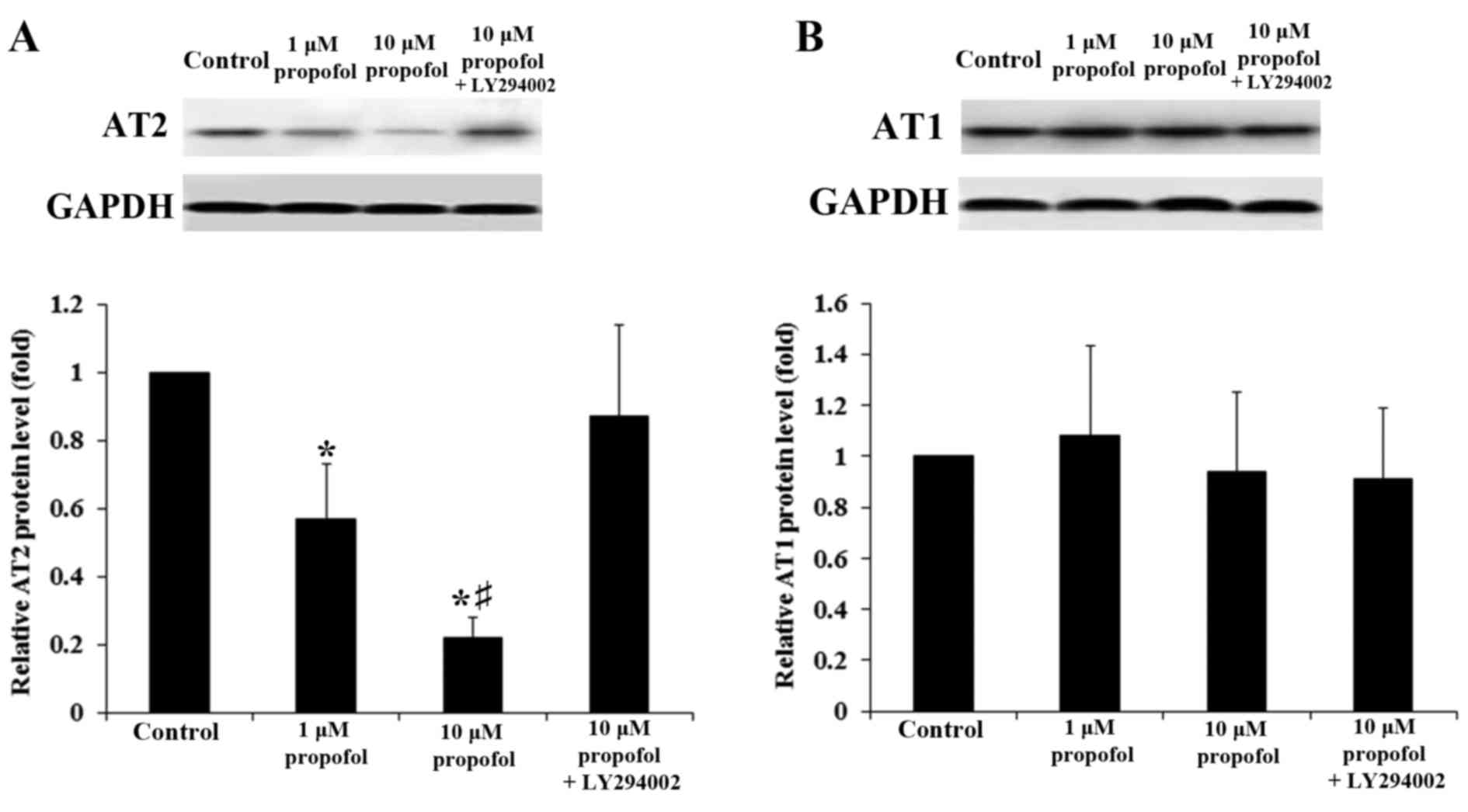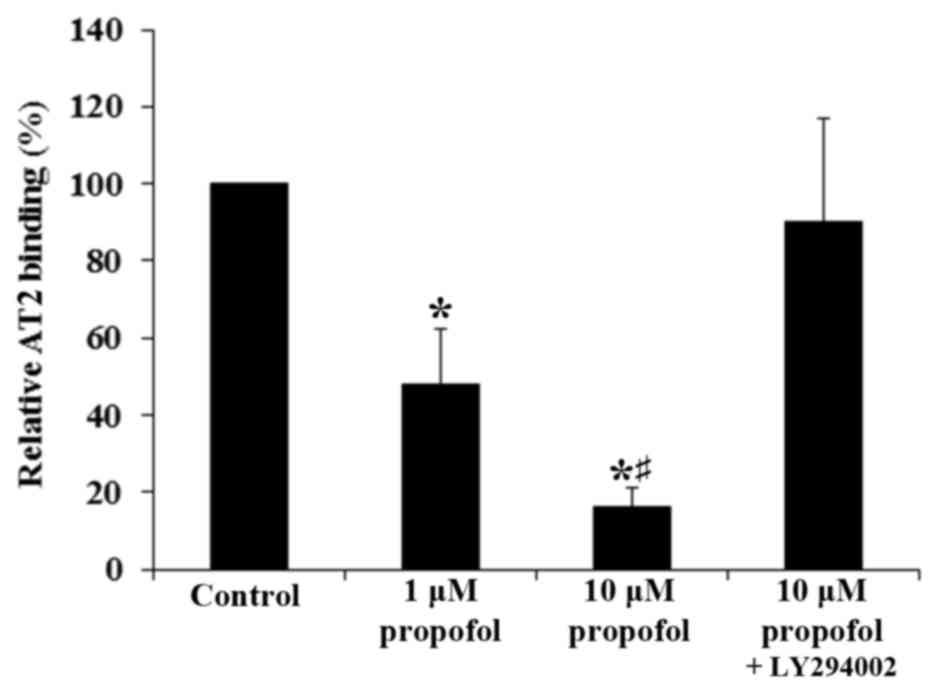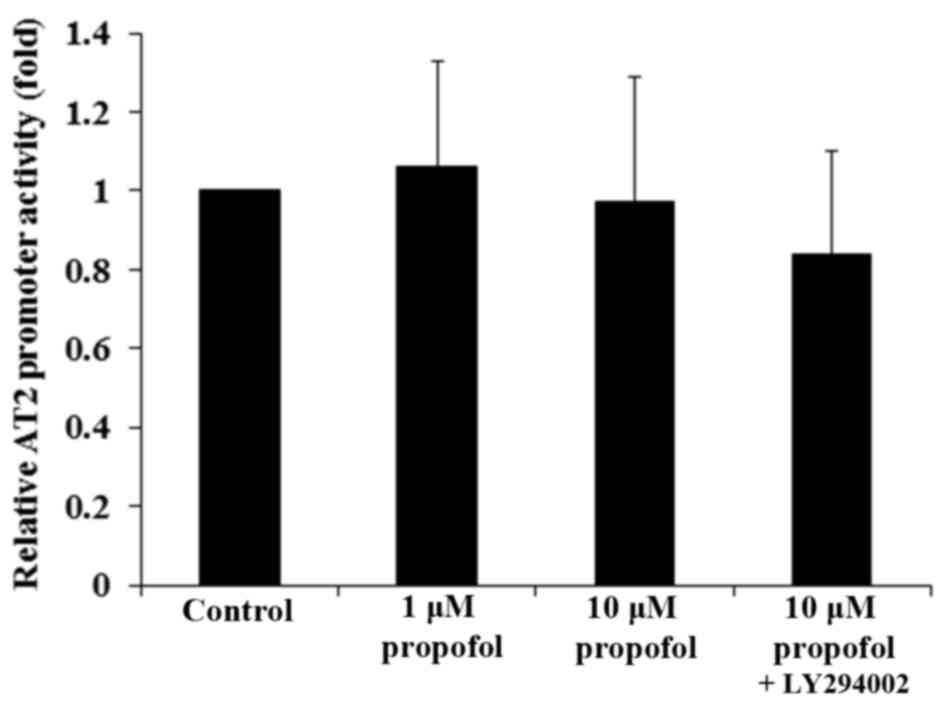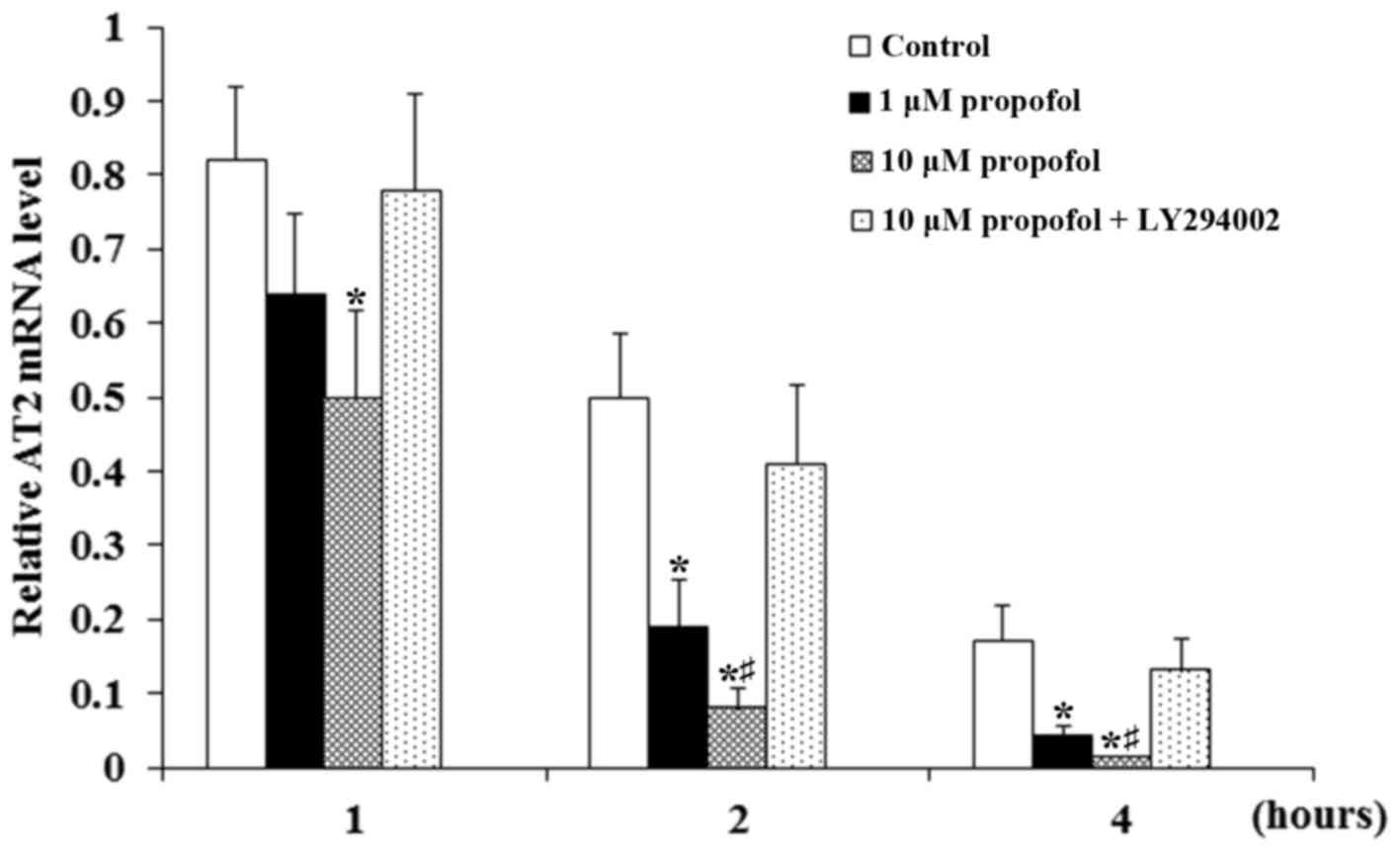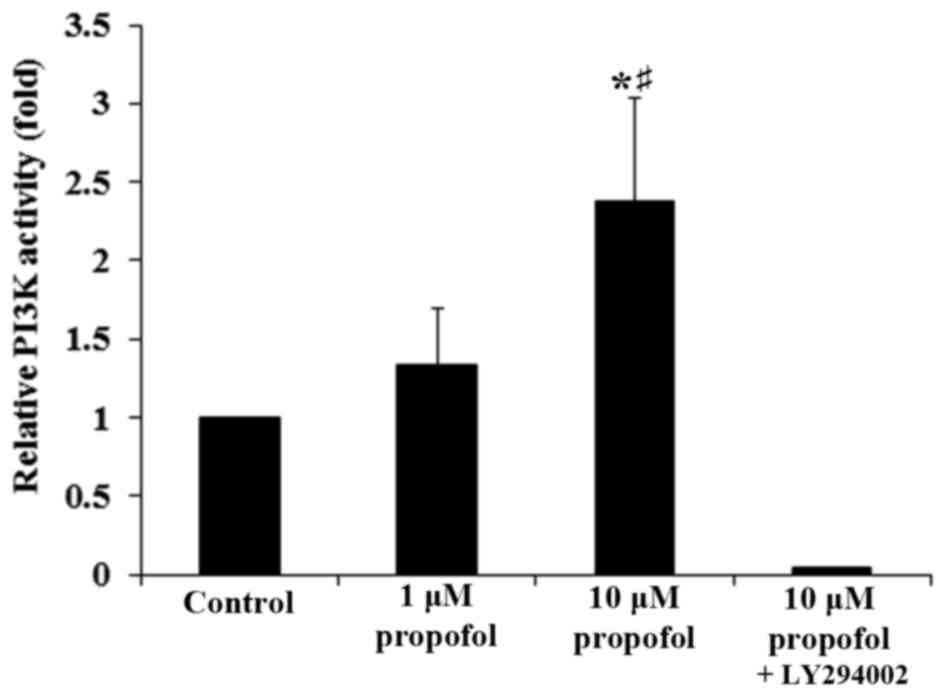Propofol inhibits expression of angiotensin II receptor type 2 in dorsal root ganglion neurons
- Authors:
- Published online on: January 12, 2017 https://doi.org/10.3892/etm.2017.4040
- Pages: 867-872
-
Copyright: © Pan et al. This is an open access article distributed under the terms of Creative Commons Attribution License.
Abstract
Introduction
The renin-angiotensin system (RAS) serves a fundamental role in regulating blood pressure and maintaining fluid homeostasis, and also processes nociceptive information (1,2). There is substantial evidence that angiotensin II (Ang II), the active principle of RAS, interacts with the autonomic system and participates in the central and peripheral regulation of sensory information (1,2). Ang II mediates its function primarily through angiotensin II receptor types 1 (AT1) and 2 (AT2) (3). While the majority of physiological effects caused by Ang II are mediated through AT1, the role of AT2 receptors remains controversial (4). It has been indicated in an animal study and a phase II clinical trial that a selective AT2 antagonist may successfully alleviate neuropathic pain, suggesting that targeting AT2 may be developed as a novel method of treating chronic inflammatory pain conditions and peripheral neuropathy (5,6).
Propofol (2,6-diisopropylphenol) is a widely used sedative-hypnotic agent that induces and maintains sedation and anesthesia in critically ill patients (7). Advantages of propofol over the application of similar agents include rapid recovery, a lower incidence of side effects and an improved quality of anesthesia (8). A previous study demonstrated that topical propofol had antihyperalgesic and antinociceptive effects on dorsal horn neurons, indicating that propofol exerts peripheral antinociceptive action (9). A potential link has also been suggested between propofol and the RAS in dorsal root ganglion (DRG) neurons, which are responsible for conducting information from the periphery to the central nervous system (CNS) (8). Thus, understanding the connection between propofol and the RAS will provide insights into potential new mechanisms of regulating RAS signaling and nociception in the peripheral nervous system. Previous studies have demonstrated that AT1 and AT2 are expressed in DRGs (3,4); therefore, in the present study the effect of propofol on the expression of AT2 and AT1 in cultured DRG neurons was assessed.
Materials and methods
Reagents
Propofol, Ang II, transcription inhibitor actinomycin D, the selective AT2 antagonist PD123319 and phosphatidylinositol 3-kinase (PI3K) inhibitor LY294002 were all purchased from Sigma-Aldrich; Merck Millipore (Darmstadt, Germany). Carrier free 125I-Sodium iodide (100 µl/ml) was purchased from GE Healthcare Biosciences (Pittsburgh, PA, USA). Rat AT2 gene promoter-luciferase reporter was generated as described previously (10). The dual-luciferase reporter assay system was purchased from Promega Corporation (Madison, WI, USA). SuperScript™ II reverse transcriptase, TRIzol® reagent and Lipofectamine® 2000 transfection reagent were all purchased from Thermo Fisher Scientific, Inc. (Waltham, MA, USA). The SYBR®-Green Real-Time PCR Master Mix was purchased from Applied Biosystems; Thermo Fisher Scientific, Inc. The PI3K Activity ELISA kit (K-1000s) was purchased from Echelon Biosciences, Inc. (Salt Lake City, UT, USA). Rabbit anti-human AT1 polyclonal antibody (sc-579), rabbit anti-human AT2 polyclonal antibody (sc-1173) and rabbit anti-human GAPDH polyclonal antibody (sc-25778) were purchased from Santa Cruz Biotechnology (Dallas, TX, USA).
Cell culture and treatment
Primary neuron medium (CC-3256) and rat DRG neurons (R-DRG-505) were purchased from Lonza Group (Basel, Switzerland). The cells were treated with different concentrations of propofol (0.5, 1, 5 or 10 µM) for different lengths of time (1, 2, 4 or 6 h). For LY29004 treatment, rat DRG neurons were pre-treated with LY294002 for 30 min and incubated at 37°C with LY294002 and 10 µM propofol for 4 h. For actinomycin D treatment, cells were pre-treated with 1 mg/ml actinomycin D for 30 min and then cultured for 1, 2 or 4 h in primary neuron medium (Lonza Group) containing 1 mg/ml actinomycin D with or without 10 µM propofol.
Reverse transcription-quantitative polymerase chain reaction (RT-qPCR)
RNAwas extracted from rat DRG neurons using TRIzol reagent followed by purification with TURBO DNA-free system (Ambion; Thermo Fisher Scientific, Inc.) for two independent times. A SuperScript II reverse transcriptase kit (Applied Biosystems; Thermo Fisher Scientific, Inc.) was used to synthesize the cDNA. RT-qPCR was performed on an ABI-PRISM 7700 Sequence Detection System (Applied Biosystems; Thermo Fisher Scientific, Inc.) with the SYBR-Green Real-Time PCR Master Mix, following the manufacturer's protocol. PCR amplification conditions were: 20 sec at 95°C, followed by 40 cycles of 5 sec at 95°C and 30 sec at 60°C. The results were normalized against that of GAPDH in the same sample. The primers used were as follows: AT2, forward, 5′-CTTCAGTTTTGCTGCCACCA-3′ and reverse, 5′-TGTGTGAGCAATTAAAGGCGG-3′; GAPDH, forward, 5′-TGCAGTGGCAAAGTGGAGATT-3′ and reverse, 5′-TTGAATTTGCCGTGAGTGGA-3′. Relative quantification of the AT2 mRNA level was determined using the 2−ΔΔCq method (11) and normalized against that of GAPDH in the same sample.
Western blot analysis
Rat DRG neurons were lysed with a hypotonic buffer containing 2% Nonidet-P and a protease inhibitor cocktail (Sigma-Aldrich; Merck Millipore, Darmstadt, Germany) by sonication three times, for 3 sec on ice. The supernatant obtained following centrifugation at 2,000 × g at 4°C for 15 min was used for protein concentration determination by the Pierce Coomassie Protein Assay kit (23200; Thermo Fisher Scientific, Inc.) according to the manufacturer's protocol. Equal quantities of protein (2 µg) from each sample were separated by 10% SDS-PAGE and blotted onto a polyvinylidene difluoride microporous membrane (EMD Millipore, Billerica, MA, USA). Membranes were blocked with 5% skim milk powder in Tris-buffered saline-Tween 20 (0.1%; TBST) at room temperature for 2 h and incubated at room temperature for 1 h with a 1:1,000 dilution of rabbit anti-human AT1 polyclonal antibody (sc-579), rabbit anti-human AT2 polyclonal antibody (sc-1173), or rabbit anti-human glyceraldehyde-3-phosphate dehydrogenase (GAPDH) polyclonal antibody (sc-25778). This was washed with TBST and incubated at room temperature for 1 h with bovine anti-rabbit (sc-2370) secondary antibody (1:5,000; Santa Cruz Biotechnology, Inc.). Peroxidase was revealed using an Amersham ECL Western Blotting Detection kit (GE Healthcare Life Shanghai, China) according to the manufacturer's protocol. A total of three independent experiments were performed.
AT2 receptor-binding assay
DRG neurons were lysed with CHAPS buffer containing 150 mmol/l sodium chloride, 10 mmol/l sodium pyrophosphate, 1% Triton X-100, 0.1% CHAPS, 40 mmol/l Tris pH 7.5, 2 mmol/l EDTA, 10% glycerol, 1 mmol/l sodium orthovanadate, 0.5 mmol/l 4-benzenesulfonyl fluoride hydrochloride, 10 mmol/l sodium fluoride, 0.5 µg/ml aprotinin and 0.5 µg/ml leupeptin. The cell lysates were incubated with 0.1 nmol/l [125I]-Sar1-Ile8-Ang II in 50 mmol/l Tris (pH 7.5) buffer containing 200 mmol/l sodium chloride, 1 mmol/l EDTA, 10 mmol/l magnesium chloride, 0.1% bovine serum albumin and 0.01% trypsin inhibitor at room temperature for 60 min in the presence of guanosine 5′-O-[gamma-thio]triphosphate. Bound radio-ligand was separated from free ligand and the radioactivity was counted using a 1205 betaplate liquid scintillation counter (Wallac; PerkinElmer, Inc., Waltham, MA, USA) according to the manufacturer's protocol. Specific AT2-receptor binding was determined by the addition of 10 µM PD123319. The disintegrations per minute data was normalized against cell number (per 20,000 cells) and presented as a percentage of untreated control cells (designated as 100%).
Luciferase reporter assay
Rat AT2 gene promoter-luciferase reporter was generated by inserting a PCR-amplified 1.3-kb rat AT2 gene promoter fragment into the SacI and NcoI sites of a promoterless basic luciferase vector pGL3-basic (Promega Corporation). Rat DRG neurons were transfected with the rat AT2 promoter-luciferase reporter plasmids followed by treatment with 1 or 10 µM propofol with or without 50 µM LY294002, for 4 h. Co-transfection of the plasmid PRL-CMV (E2261; Promega Corporation) encoding Renilla reniformis luciferase (at one fifth molar ratio to test plasmids) was performed, with test plasmids in each transfection acting as an internal control to allow data normalization. Luciferase assays were performed 24 h following propofol treatment with the dual-luciferase reporter assay system according to the manufacturer's protocol.
Measurement of mRNA stability
Rat DRG neurons were pre-treated with 1 mg/ml actinomycin D for 30 min and cultured for 1, 2 or 4 h in primary neuron medium (Lonza Group) containing 1 mg/ml actinomycin D with or without 10 µM propofol. mRNA expression of AT2 was determined with RT-qPCR following 1, 2 and 4 h propofol treatment and expressed as fold changes relative to that of control cells immediately prior to propofol treatment (designated as 1).
PI3K activity assay
A PI3K Activity ELISA kit was used to assess PI3K activity, according to the manufacturer's protocol (12,13). PI3K was isolated by immunoprecipitation using a rabbit anti-human PI3K polyclonal antibody (1:500; 06–195; Merck Millipore, Darmstadt, Germany) to the p85 adapter subunit to directly assess PI3K activity. The ability of the co-precipitated catalytic p110 catalytic subunit to convert a standard phosphatidylinositol (4,5)-bisphosphate to phosphatidylinositol (3,4,5)-triphosphate (PIP3) in a kinase reaction was assessed by measuring the PIP3 generated using the ELISA kit.
Statistical analysis
Statistical analyses were performed using SPSS for Windows 19.0 (IBM, Armonk, NY, USA). All continuous variable values were expressed as mean ± standard deviation. Comparisons of the mean among multiple groups were performed with one-way analysis of variance followed by post hoc pairwise comparisons using Tukey tests. P<0.05 was considered to indicate a statistically significant difference.
Results
Propofol inhibits AT2 expression and ligand-binding on DRG neurons
To examine the potential effect of propofol on the expression of AT2 in DRG, DRG neurons were treated with different concentrations of propofol (0.5, 1, 5 or 10 µM) for different lengths of time (1, 2, 4 or 6 h). A concentration range of 0.5–5 µM propofol decreased the AT2 mRNA level in DRG neurons in a statistically significant concentration-dependent manner (P<0.05) until reaching a plateau at 5–10 µM. The effect of propofol on AT2 mRNA expression was eliminated by the PI3K inhibitor LY294002 (Table I). Propofol with the concentration 0.5 µM had no significant effect on the AT2 mRNA level over time. However, propofol with a concentration of 1–10 µM decreased the AT2 mRNA level in a statistically significant time-dependent manner (P<0.05) until reaching a plateau at 4–6 h. This decrease was reversed by the addition of LY294002 (Table I). By contrast, treatment for 6 h with 10 µM propofol exerted no significant effect on the AT1 mRNA level (data not shown).
Table I.Relative angiotensin II type 2 receptor mRNA levels in rat dorsal root ganglion neurons following propofol treatment. |
Western blot analysis confirmed that propofol decreased levels of AT2 protein in DRG neurons within 4 h treatment in a concentration-dependent manner (P<0.05). This decrease was reversed with the addition of LY294002 (Fig. 1A); by contrast, propofol exerted no significant effect on the levels of AT1 proteins in DRG neurons (P>0.05; Fig. 1B). In line with the aforementioned findings, propofol significantly decreased the AT2-specific binding of Ang II to the cell membrane of DRG neurons in a concentration-dependent manner (P<0.05). This was reversed with the addition of LY294002 (Fig. 2). These results suggest that propofol inhibited the expression of AT2 but not AT1 in DRG neurons at the mRNA and protein levels by a PI3K-depedent mechanism, leading to a significant decrease in the density of Ang II-binding AT2 on the cell membrane (P<0.05).
Propofol decreases AT2 mRNA stability in DRG neurons by a PI3K-depedent mechanism
To examine whether propofol decreased AT2 mRNA expression in DRG neurons by transcriptionally inhibiting the AT2 gene promoter, DRG neurons were transfected with an AT2 gene promoter/luciferase reporter. Luciferase reporter assays demonstrated that propofol had no significant effect on AT2 gene promoter activity (Fig. 3; P>0.05), suggesting that propofol may not decrease the AT2 mRNA level in DRG neurons by inhibiting the gene promoter or transcription. The effect of propofol on AT2 mRNA stability was subsequently assessed using DRG neurons pre-treated with the transcription inhibitor actinomycin D for 30 min, and then cultured for 1, 2 or 4 h in medium containing actinomycin D with or without propofol. AT2 mRNA expression was determined using RT-qPCR following 1, 2 and 4 h propofol treatment and expressed as fold changes relative to mRNA expression in control cells prior to propofol treatment.
Propofol significantly enhanced the decrease in AT2 mRNA expression that occurred over time compared with the control (P<0.05; Fig. 4). The decrease was greatest in neurons treated with 10 µM propofol. Furthermore, the effect became much more pronounced over time during actinomycin treatment but was eliminated following the addition of LY294002 at each time point (Fig. 4). The results suggest that propofol decreased the stability of the AT2 mRNA in DRG neurons through a PI3K-depedent mechanism. Furthermore, propofol significantly increased PI3K activity in DRG neurons in a concentration-dependent manner, which was completely reversed following the addition of LY294002 (P<0.05; Fig. 5). This demonstrates that a PI3K-depedent mechanism may be involved in the effect of propofol on the expression of AT2 in DRG neurons.
Discussion
The RAS is involved in nociception and affects the cardiovascular system (1,2). The active principle of RAS is AT2, which functions to mediate the effect of Ang II; due to this, AT2 has become a novel therapeutic target to treat peripheral neuropathic pain (5,6). As a popular induction agent for general anesthesia, propofol exerts peripheral antinociceptive effects (9). To the best of our knowledge, the present study provides the first evidence indicating that propofol inhibits the expression of AT2 in DRG neurons, which conduct information from the periphery to CNS and are therefore linked to peripheral neuropathic pain (8).
It has been reported that Ang II interacts with the autonomic system and participates in the central and peripheral regulation of sensory information (14). Ang II exerts its physiological action by acting as an agonist for AT1 and AT2 (15). Ang II/AT1 signaling has been well characterized in the cardiovascular system, tumorigenesis, tissue remodeling, the renal system, cognition, embryonic development, reproduction and bone homeostasis (16). Additionally, it has been suggested that Ang II/AT2 signaling serves a key role in the pathobiology of peripheral neuropathic pain, since selective AT2 antagonists have been demonstrated to produce dose-dependent analgesia in rat models of peripheral neuropathic pain, as well as in a phase II clinical trial (5,6). In the present study, propofol with a concentration of 0.5–5 µM decreased expression of AT2 mRNA in a statistically significant dose- and time-dependent manner within 4 h of treatment, resulting in decreased density of Ang II-binding AT2 on the cell membrane of DRG neurons. Notably, 10 µM propofol decreased the expression of AT2 and its Ang II-binding activity in DRG neurons by ~80% within 4 h, suggesting that propofol is a strong inhibitor of Ang II/AT2 signaling in DRG neurons and thus may be useful for the clinical treatment of peripheral neuropathic pain. A PI3K inhibitor eliminated the effect of propofol, suggesting that the inhibitory effect of propofol on the expression of AT2 in DRG neurons occurs in a PI3K-depedent manner. This was corroborated by the finding that propofol increased PI3K activity in DRG neurons in a concentration-dependent manner (Fig. 5). In addition, the results of the current study suggest that propofol inhibits the expression of AT2 in DRG neurons by decreasing the stability of AT2 mRNA. Further studies are required to elucidate the mechanisms by which propofol decreases the stability of the AT2 mRNA via PI3K signaling.
The general anesthetic properties of propofol may be due to its function of enhancing GABA and glycinergic neurotransmission (17). Analgesic effects of subhypnotic doses of propofol in humans have been reported in several studies investigating experimental pain (18,19). Due to the potentially important role of Ang II/AT2 signaling in peripheral nociception (5,6), the finding that propofol inhibits the expression of AT2 in DRG neurons indicates a novel mechanism for the peripheral antinociceptive action of propofol. A previous study has suggested a mechanism of peripheral antinociceptive action of propofol by demonstrating that propofol upregulates the expression of Mas, a receptor of Ang-(1–7), in DRG neurons (8). Ang-(1–7)/Mas signaling is a component of the RAS signaling system and is similar to Ang II/AT2 signaling (8). Therefore, future studies should assess how the propofol-regulated expression of AT2 and Mas in DRG neurons relate to each other and orchestrate antinociceptive action.
In conclusion, to the best of our knowledge, the present study provides the first evidence indicating that propofol inhibits the expression of AT2 in DRG neurons via decreasing AT2 mRNA stability through a PI3K-dependent mechanism. The results add novel insights into the mechanisms of the peripheral antinociceptive action of propofol and suggest a potential novel means of regulating Ang II/AT2 signaling in the peripheral nervous system.
References
|
Pelegrini-da-Silva A, Martins AR and Prado WA: A new role for the renin-angiotensin system in the rat periaqueductal gray matter: Angiotensin receptor-mediated modulation of nociception. Neuroscience. 132:453–463. 2005. View Article : Google Scholar : PubMed/NCBI | |
|
Sakagawa T, Okuyama S, Kawashima N, Hozumi S, Nakagawasai O, Tadano T, Kisara K, Ichiki T and Inagami T: Pain threshold, learning and formation of brain edema in mice lacking the angiotensin II type 2 receptor. Life Sci. 67:2577–2585. 2000. View Article : Google Scholar : PubMed/NCBI | |
|
Pavel J, Tang H, Brimijoin S, Moughamian A, Nishioku T, Benicky J and Saavedra JM: Expression and transport of Angiotensin II AT1 receptors in spinal cord, dorsal root ganglia and sciatic nerve of the rat. Brain Res. 1246:111–122. 2008. View Article : Google Scholar : PubMed/NCBI | |
|
Anand U, Facer P, Yiangou Y, Sinisi M, Fox M, McCarthy T, Bountra C, Korchev YE and Anand P: Angiotensin II type 2 receptor (AT2R) localization and antagonist-mediated inhibition of capsaicin responses and neurite outgrowth in human and rat sensory neurons. Eur J Pain. 17:1012–1026. 2013. View Article : Google Scholar : PubMed/NCBI | |
|
Smith MT, Wyse BD and Edwards SR: Small molecule angiotensin II type 2 receptor (AT2R) antagonists as novel analgesics for neuropathic pain: Comparative pharmacokinetics, radioligand binding, and efficacy in rats. Pain Med. 14:692–705. 2013. View Article : Google Scholar : PubMed/NCBI | |
|
Rice AS, Dworkin RH, McCarthy TD, Anand P, Bountra C, McCloud PI, Hill J, Cutter G, Kitson G, Desem N, et al: EMA401, an orally administered highly selective angiotensin II type 2 receptor antagonist, as a novel treatment for postherpetic neuralgia: A randomised, double-blind, placebo-controlled phase 2 clinical trial. Lancet. 383:1637–1647. 2014. View Article : Google Scholar : PubMed/NCBI | |
|
Marik PE: Propofol: An immunomodulating agent. Pharmacotherapy. 25:28S–33S. 2005. View Article : Google Scholar : PubMed/NCBI | |
|
Cao L, Xun J, Jiang X and Tan R: Propofol up-regulates Mas receptor expression in dorsal root ganglion neurons. Pharmazie. 68:677–680. 2013.PubMed/NCBI | |
|
Takechi K, Carstens MI, Klein AH and Carstens E: The antinociceptive and antihyperalgesic effects of topical propofol on dorsal horn neurons in the rat. Anesth Analg. 116:932–938. 2013. View Article : Google Scholar : PubMed/NCBI | |
|
Ichiki T, Kambayashi Y and Inagami T: Transcription of the rat angiotensin II type 2-receptor gene. Biochem Biophys Res Commun. 222:566–571. 1996. View Article : Google Scholar : PubMed/NCBI | |
|
Livak KJ and Schmittgen TD: Analysis of relative gene expression data using real-time quantitative PCR and the 2-(Delta Delta C(T)) method. Methods. 25:402–408. 2001. View Article : Google Scholar : PubMed/NCBI | |
|
Cao CM, Zhang Y, Weisleder N, Ferrante C, Wang X, Lv F, Zhang Y, Song R, Hwang M, Jin L, et al: MG53 constitutes a primary determinant of cardiac ischemic preconditioning. Circulation. 121:2565–2574. 2010. View Article : Google Scholar : PubMed/NCBI | |
|
Fos C, Salles A, Lang V, Carrette F, Audebert S, Pastor S, Ghiotto M, Olive D, Bismuth G and Nunès JA: ICOS ligation recruits the p50alpha PI3K regulatory subunit to the immunological synapse. J Immunol. 181:1969–1977. 2008. View Article : Google Scholar : PubMed/NCBI | |
|
Yang Y, Wu H, Yan JQ, Song ZB and Guo QL: Tumor necrosis factor-α inhibits angiotensin II receptor type 1 expression in dorsal root ganglion neurons via β-catenin signaling. Neuroscience. 248:383–391. 2013. View Article : Google Scholar : PubMed/NCBI | |
|
Verdonk K, Danser AH and van Esch JH: Angiotensin II type 2 receptor agonists: Where should they be applied? Expert Opin Investig Drugs. 21:501–513. 2012. View Article : Google Scholar : PubMed/NCBI | |
|
Paul M, Mehr A Poyan and Kreutz R: Physiology of local renin-angiotensin systems. Physiol Rev. 86:747–803. 2006. View Article : Google Scholar : PubMed/NCBI | |
|
Yamakura T, Bertaccini E, Trudell JR and Harris RA: Anesthetics and ion channels: Molecular models and sites of action. Annu Rev Pharmacol Toxicol. 41:23–51. 2001. View Article : Google Scholar : PubMed/NCBI | |
|
Bandschapp O, Filitz J, Ihmsen H, Berset A, Urwyler A, Koppert W and Ruppen W: Analgesic and antihyperalgesic properties of propofol in a human pain model. Anesthesiology. 113:421–428. 2010. View Article : Google Scholar : PubMed/NCBI | |
|
Hand R Jr, Riley GP, Nick ML, Shott S and Faut-Callahan M: The analgesic effects of subhypnotic doses of propofol in human volunteers with experimentally induced tourniquet pain. AANA J. 69:466–470. 2001.PubMed/NCBI |



